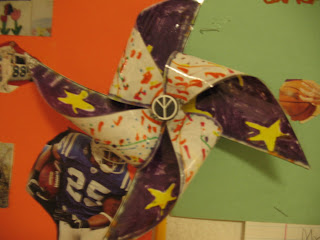
Dandelion Fields by Walker in Kindergarten
I don't often teach projects that can be done in one day. Usually, I choose projects that take several weeks to complete. The benefits are that the students' persistence, attention span, and their ability to conceptualize are strengthened.
But, at the end of the year, it's nice to have quick and uncomplicated projects.
Using a variety of green crayons, fingers tips, and yellow paint students made a field of dandelions.
Coloring the grass, and using restraint in painting dandelions was harder than you might think. I really press my students to do their best work, and in the end they are proud of their efforts.
While walking around praising and giving suggestions to students I over heard a quiet student named Walker remark to his table mate, "My mom is going to love this." As soon as he had finished saying these words he noticed that I was listening to him. I said, "Your right!" which caused Walker to get a big smile on his face.
I love that he was able to identify that his work was done well, that he was certain it would be appreciated by others, and that he felt pride in his work.
*Sigh,* another example of the transformative powers of art.



































